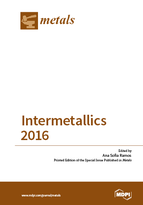Intermetallics 2016
A special issue of Metals (ISSN 2075-4701).
Deadline for manuscript submissions: closed (30 June 2016) | Viewed by 95292
Special Issue Editor
Interests: nanomaterials; reactive multilayers; intermetallics; sputtering; joining; self-healing
Special Issues, Collections and Topics in MDPI journals
Special Issue Information
Dear Colleagues,
The combination of low density, high strength, and good corrosion resistance makes intermetallics promising for structural applications, especially at high temperatures and in severe environments. Intermetallic compounds can be produced from metals that exothermically react with each other, releasing energy that is useful for several applications, including joining. Furthermore, these materials also have potential for functional applications since some intermetallic phases have unique properties, such as shape memory or thermo electric effect. Intermetallic phases of interest include aluminides, silicides, Laves and Heusler phases, among others. As a result of the increasing demand for novel/advanced materials with improved properties, recent years have been marked by the return of intermetallics.
This Special Issue will cover recent progress and new developments regarding all aspects of intermetallic-based materials, including processing, joining, modeling, characterization, testing, and application. From the application perspective, contributions related to intermetallic-based materials intended for structural, as well as for functional, applications are welcome.
Papers focusing on innovative theoretical or experimental approaches to understand the complex relationship between structure, property, and functionality of intermetallic materials or multiphase alloys, where intermetallic compounds are the major constituents, are invited for inclusion in this Special Issue.
Dr. A. S. Ramos
Guest Editor
Manuscript Submission Information
Manuscripts should be submitted online at www.mdpi.com by registering and logging in to this website. Once you are registered, click here to go to the submission form. Manuscripts can be submitted until the deadline. All submissions that pass pre-check are peer-reviewed. Accepted papers will be published continuously in the journal (as soon as accepted) and will be listed together on the special issue website. Research articles, review articles as well as short communications are invited. For planned papers, a title and short abstract (about 100 words) can be sent to the Editorial Office for announcement on this website.
Submitted manuscripts should not have been published previously, nor be under consideration for publication elsewhere (except conference proceedings papers). All manuscripts are thoroughly refereed through a single-blind peer-review process. A guide for authors and other relevant information for submission of manuscripts is available on the Instructions for Authors page. Metals is an international peer-reviewed open access monthly journal published by MDPI.
Please visit the Instructions for Authors page before submitting a manuscript. The Article Processing Charge (APC) for publication in this open access journal is 2600 CHF (Swiss Francs). Submitted papers should be well formatted and use good English. Authors may use MDPI's English editing service prior to publication or during author revisions.
Keywords
- Self-propagating high-temperature synthesis
- Shape memory alloys
- Intermetallic composites
- Reactive materials
- Modeling and numerical simulations
- Phase transformations
- Defects and diffusion mechanisms
- Environmental effects, including oxidation and corrosion
- Mechanical properties
- Fracture and crack growth
- Medical applications
- Energy storage applications
- Novel structural and functional applications
- Joining






